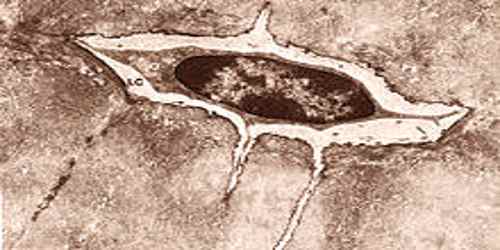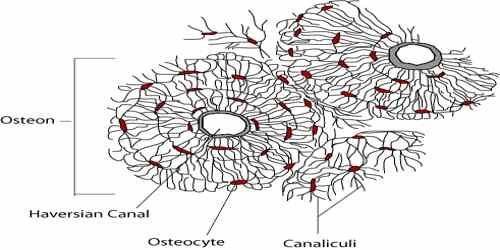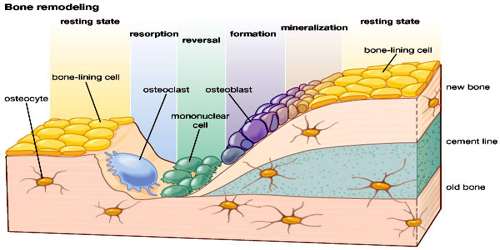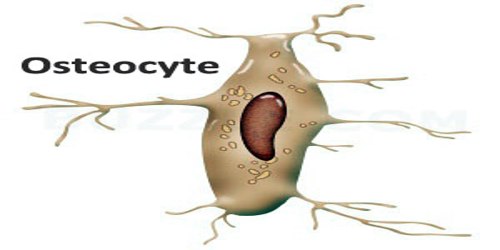Osteocyte
Definition
Osteocyte is a cell characteristic of mature bone tissue. It is derived from osteoblasts and embedded in the calcified matrix of bone. Osteocytes are found in small, round cavities called lacunae and have thin, cytoplasmic branches. The adult human body has about 42 billion osteocytes. Osteocytes have an average half life of 25 years, they do not divide, and they are derived from osteoprogenitors, some of which differentiate into active osteoblasts. Osteoblasts/osteocytes develop in mesenchyme.

Cytoplasmic processes of the osteocyte extend away from the cell toward other osteocytes in small channels called canaliculi. By means of these canaliculi, nutrients and waste products are exchanged to maintain the viability of the osteocyte. Osteocytes are the most abundant type of cell in mature bone tissue. They also are long-lived, surviving as long as the bone they occupy exists.
Although osteocytes have reduced synthetic activity and (like osteoblasts) are not capable of mitotic division, they are actively involved in the routine turnover of bony matrix, through various mechanosensory mechanisms. They destroy bone through a rapid, transient (relative to osteoclasts) mechanism called osteocytic osteolysis. Hydroxyapatite, calcium carbonate and calcium phosphate is deposited around the cell.
Structure and Functions of Osteocyte
Bone tissue creation begins with osteoblasts. These cells create certain substances that help make up bone tissue, including collagen and other proteins. In some cases, once an osteoblast has finished creating the necessary substances to form bone, it gets surrounded by bone minerals and transforms into an osteocyte.
Osteocytes are mature osteoblasts that have become trapped within the very bone matrix they produced. Osteocytes continue to form bone to some degree, which is important for maintaining the strength and health of the bone matrix. However, osteocytes perform functions that extend far beyond simple maintenance. These have a stellate shape, approximately 7 micrometers deep and wide by 15 micrometers in length. The cell body varies in size from 5-20 micrometers in diameter and contains 40-60 cell processes per cell, with a cell to cell distance between 20-30 micrometers. A mature osteocyte contains a single nucleus that is located toward the vascular side and has one or two nucleoli and a membrane. The cell also exhibits a reduced size endoplasmic reticulum, Golgi apparatus and mitochondria, and cell processes that radiate towards the mineralizing matrix. Osteocytes form an extensive connecting syncitial network via small cytoplasmic/dendritic processes in canaliculi.

Osteocytes contain glutamate transporters that produce nerve growth factors after bone fracture, which provides evidence of a sensing and information transfer system. When osteocytes were experimentally destroyed, the bones showed a significant increase in bone resorption, decreased bone formation, trabecular bone loss, and loss of response to unloading.
The osteocyte is capable of bone deposition and resorption. It also is involved in bone remodeling by transmitting signals to other osteocytes in response to even slight deformations of bone caused by muscular activity. In this way, bone becomes stronger if additional stress is placed on it (for example, by frequent exercise or physical exertion) and weaker if it is relieved of stress (for example, by inactivity). The osteocyte may aid in calcium removal from bone when the body’s calcium level drops too low. The premature death or dysfunction of osteocytes is associated with diseases such as osteoporosis and osteoarthritis.
Bone Remodeling & Repair
Osteocytes comprise 95% of the living cells in adult bone. They are the longest-lived of all bone cells; many osteocytes survive for decades within their bony chambers. Although each osteocyte is physically isolated within the bone matrix, it communicates with nearby osteocytes, osteoblasts, osteoclasts, and even distant tissues and organs through multiple canaliculi that penetrate the surrounding bone. Like an octopus, each osteocyte extends tentacle-like dendrites into its canaliculi, and these dendrites allow the osteocyte to maintain direct contact with its neighbors.

One of the better-studied substances secreted by osteocytes is a protein called sclerostin. Only osteocytes produce this compound, which inhibits osteoblast activity and stimulates osteoclast activity. Hence, when an osteocyte secretes more sclerostin, the production of new bone slows. Not surprisingly, in bones that are subjected to heavy physical loads, osteocytes secrete less sclerostin. Less sclerostin levels allow heightened osteoblast activity, which permits the production of additional bone in areas that are under stress.
Osteocyte cell death can occur in association with pathologic conditions such as osteoporosis and osteoarthritis, which leads to increased skeletal fragility, linked to the loss of ability to sense microdamage and/or signal repair. Oxygen deprivation that occurs as the result of immobilization (bed rest), glucocorticoid treatment, and withdrawal of oxygen have all been shown to promote osteocyte apoptosis.
Reference:
















